With a remarkable 92% growth in chatbot usage globally, there are high chances that you might’ve used a chatbot like ChatGPT or Gemini to get answers to your questions or write an essay without much effort. However, use cases for these programs extend beyond just that.
It can be an excellent addition to your enterprise to cut down employee effort, boost productivity, and enhance customer satisfaction. Let’s look at some examples of chatbots that are changing the way businesses operate.
What is a Chatbot?
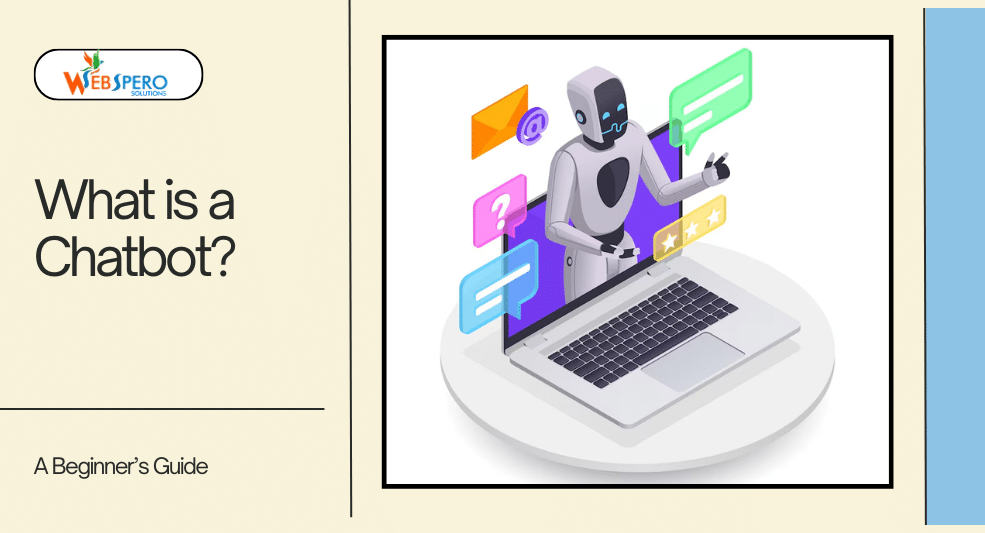
As the name suggests, it is a computer program or script specifically designed to perform real-time, contextual conversations with humans. It can be used in a variety of ways, from helping you interact better with your mobile devices to writing complex codes.
From a business perspective, a chatbot is a flexible and powerful tool that can be used to answer FAQs, help customers choose the right product or service, and even help them place an order.
Additionally, a chatbot based on natural language processing (NLP), machine learning (ML), and generative AI can learn over time, making them even more valuable to your business.
Difference Between Chatbot and Bot
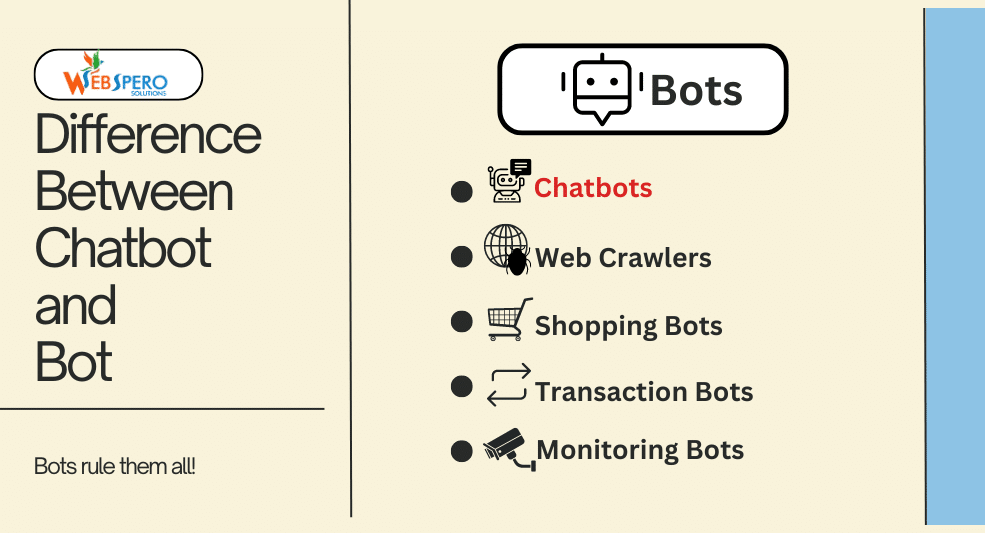
You must’ve also heard of the term Bot. Interestingly, chatbots are just a subset of the family of bots.
So, what exactly is a Bot?
It is an algorithm that is designed to perform automated tasks over the Internet. It can interact with other systems to carry out specific functions, and it usually performs in the background. Think of a Twitter bot as an example. It lets you schedule posts or automatically post content; however, you don’t communicate with it.
Let’s go over Chatbot, one more time.
This specific subset of the bot family can be understood as a program that communicates with users and responds to their queries just like a human. For example, Dom, Domino’s Interactive Chatbot. You can interact with it via text or voice and it can help you place a new order and track an existing order.
History of Chatbots
You might think chatbots were developed in the early 2010s, but they have been around for over five decades. Here are the most significant ones:
ELIZA
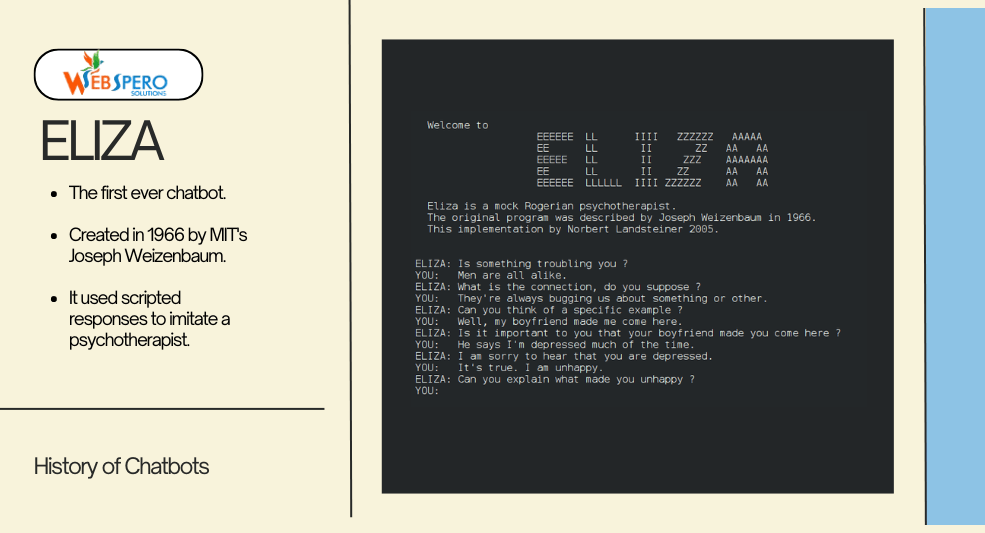
The first chatbot, known as ELIZA, was developed in 1966 by MIT Professor Joseph Weizenbaum.
Unlike modern chatbots, it relied on scripted responses to mimic a psychotherapist. While it did not generate new responses and was designed to be a mere imitation of human conversation, it did have a significant impact on users and NLP.
Weizenbaum soon found that users were writing down their most profound thoughts in ELIZA. Experts at the time claimed that within a couple of years, there would be no difference between chatbots and humans. However, Weizenbaum disagreed and stated:
“Man is not a machine… although man most certainly processes information, he does not necessarily process it in the way computers do. Computers and men are not species of the same genus. …. No other organism, and certainly no computer, can be made to confront genuine human problems in human terms. … However much intelligence computers may attain, now or in the future, theirs must always be an intelligence alien to genuine human problems and concerns.”
PARRY
Fast forward to 1972, when a new chatbot was developed by American psychiatrist Kenneth Colby. Unlike ELIZA, PARRY was designed to imitate behavior and responses of a paranoid patient.
Interestingly, it became the first chatbot to pass the Turing Test. In this specific test, interrogators were communicating with PARRY via keyboard and were unable to distinguish PARRY from a paranoid person.
| Turing Test: A process or method that is designed to determine whether or not a computer is capable of thinking like a human being. To pass the Turing Test, a human being should not be able to distinguish between responses generated by a machine and a human. |
Jabberwacky
While the previous two chatbots were designed with mental health in mind, Jabberwacky was the first chatbot to communicate in an entertaining way.
According to Rollo Carpenter, its developer, the sole purpose of Jabberwacky was to pass the Turing Test. It was created in 1988 and worked on an AI technique called contextual pattern matching.
Dr. Sbaitso
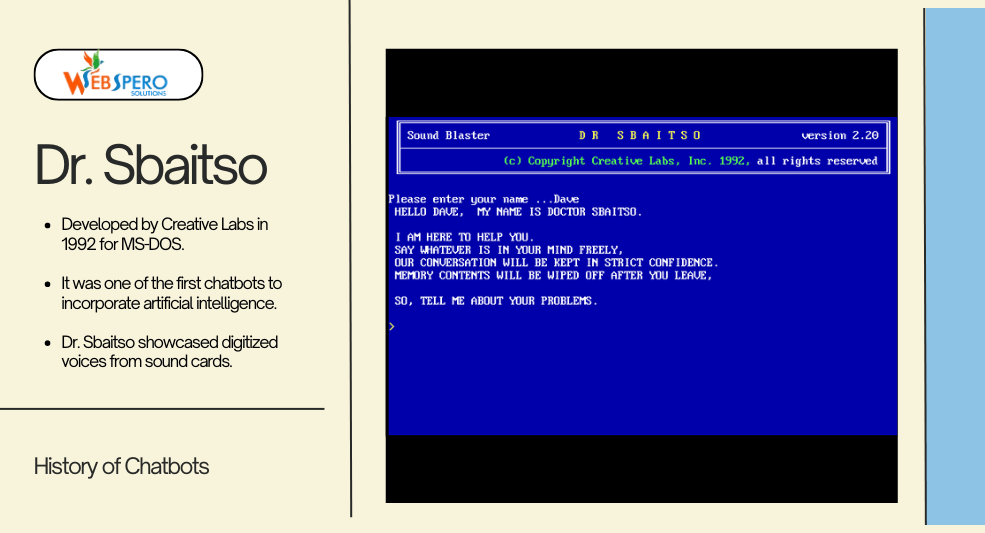
In 1992, Creative Labs created Dr. Sbaitso for MS-Dos, and it was one of the first chatbots to incorporate artificial intelligence.
It was an artificial intelligence speech synthesis program to be exact, that was designed to showcase the digitized voices produced by sound cards, making it a text-to-speech program.
The speech response was very machine-like, and it mostly responded with “WHY DO YOU FEEL THAT WAY?” Yet Dr. Sbaitso was unique at the time.
If you want to play around with it yourself, you can here!
A.L.I.C.E.
Short for Artificial Linguistic Internet Computer Entity, it was a universal language-processing chatbot introduced in 1995 by Richard Wallace. It used heuristic pattern matching.
A.L.I.C.E. was one of the most advanced chatbots at the time, and it was awarded the Loebner Prize three times. It is an award given to computer programs that are most human-like.
It was originally known as Alicebot, and it was the first chatbot to run on a computer named Alice. The program was rewritten in Java in 1998.
| Interesting Fact: A.L.I.C.E. served as inspiration for the movie Her. |
Siri
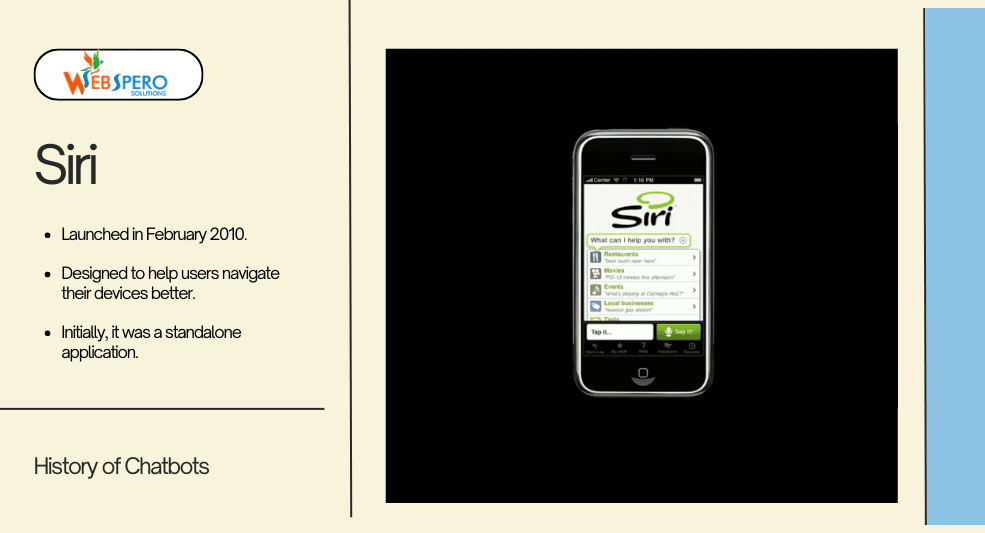
Even if you’ve never used an iPhone, you can still recognize Siri. It was first introduced by Apple by 2010.
Although it was first introduced as a personal assistant that’ll help you navigate your mobile device better, it soon developed into a full-fledged virtual assistant. Siri also paved the path for upcoming virtual assistants.
Google Now
Launched in 2012 under the name of Google Now, this was the true competition to Siri.
However, unlike Siri, Google Now understands context better and provides information based on location and time.
Alexa
Created by Amazon in 2014, Alexa is a virtual assistant capable of NLP that eases daily tasks like creating a to-do list, setting alarms, playing music, and providing weather updates.
ChatGPT

Developed by OpenAI, this AI-powered chatbot took the world by storm in 2021. This was the first AI chatbot to generate human-like text based on the inputs and understood context. It was based on the large language model (LLM).
In fact, it was so popular that it had over 152 million visitors in its first month. For reference, the social media platform Instagram took over two years to reach 100 million users.
Google Gemini
After the rise of ChatGPT, basically, every major tech company came up with its own AI chatbot. However, Google Gemini (formerly known as Google Bard) was easy to use and as accurate as ChatGPT.
Market Share of Chatbots
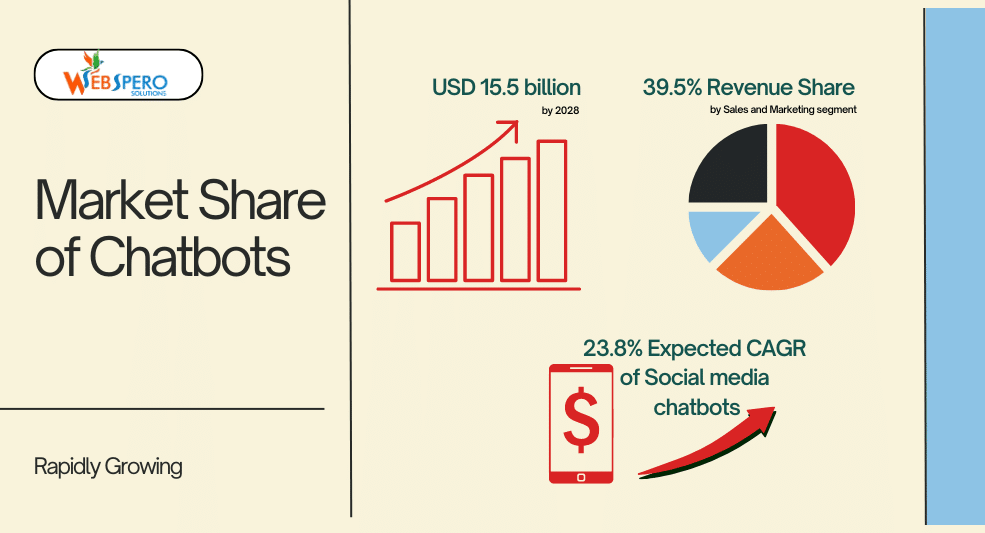
Chatbot is one of the fastest-growing industries in the world.
- According to statistics, the chatbot market is expected to grow from USD 5.4 billion in 2023 to USD 15.5 billion by 2028.
- The sales and marketing segment dominates the market with a revenue share of 39.5% in 20222.
- The global healthcare chatbot market size is estimated at USD 4,355.6 million in 2030.
- As per 2022 statistics, North America has the largest revenue share of chatbots at 30.7%
- Social media chatbots are expected to register a Compound Annual Growth Rate (CAGR) of 23.8% during the forecast period.
Types of Chatbots
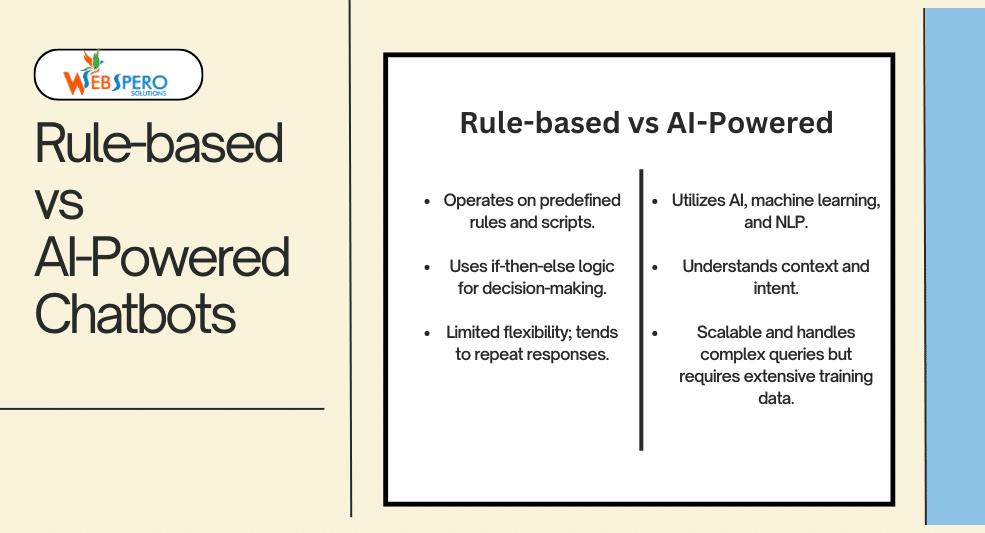
Although all chatbots may appear similar as they respond to your text input, there are fundamentally two types of chatbots: Rule-based and AI-powered Chatbots.
Rule-based Chatbot
Also known as Fundamental Chatbot, this type works based on predefined rules and scripts. While it can communicate like a human, its responses are limited.
How It Works
It works on if-then-else logic, i.e., If a certain condition is true, then the program will take a specific action, else, it will take a different action. For example, if a user is logged in, it will prompt the next action, i.e., take them to the dashboard. However, if the user is not logged in, it will prompt the login screen.
Benefits
Easy to develop
Requires less training data
Limitations
Not flexible (tend to repeat itself)
Lacks human touch
AI-powered Chatbot
This type of chatbot is capable of carrying out complete human-like conversations by utilizing artificial intelligence, machine learning, and natural language processing (NLP) like tokenization, stemming, and lemmatization.
How It Works
AI chatbot understands the context of user inputs, recognizes the intent, and generates appropriate responses. Moreover, it continually improves by learning from past interactions.
For instance, if a user types “I need help with my order.” The AI assistant will understand the context of the input and will understand that user is seeking assistance with an existing order. It might then ask, “Could you please provide your order number?” Upon receiving the order number, the order details will be provided.
Benefits
Offers great scalability
Easily handles complex queries
Limitations
Requires vast training data
Types of AI-powered Chatbots
AI-powered chatbots can be further divided into two categories: Open-source and Proprietary (closed-source) chatbots.
Open-source AI Chatbots
As the name suggests, these are chatbots whose source code is publicly available. This means developers can run the core chatbot, enabling them to modify and improve it according to their needs. For example, Meta’s Llama 3 is one of the largest open-source AI models.
Benefits
- Customization: These are highly customizable. Developers have complete control over the chatbot’s functionality and design.
- Community Support: Large communities contribute to continuous improvement and provide valuable resources.
- Cost-effective: Open-source AI models are very cost-effective from a business perspective because these are typically free to use.
Limitations
- Technical Complexities: Requires a strong understanding of programming and machine learning to implement and maintain.
- Time-consuming: Customization and maintenance can take significant time and resources.
- Security Concerns: These are one of the main limitations of these models. As the code is publicly available, it may be more susceptible to vulnerabilities.
Proprietary (closed-source) AI Chatbots
These are proprietary software solutions whose source code is not accessible to the public. Companies typically offer them as a service with predefined functionalities. Think of OpenAI’s GPT4 as an example. While OpenAI does provide API, which can be used to create custom chatbots, the source code is not made public.
Benefits
- Better Performance: These typically perform better, as they are backed by research and push the boundaries of LLMs.
- Easy-to-Use: Compared to open-source models, these are very easy to use and come with ready-to-use features.
- Support and Maintenance: Providers (creators of the model) offer ongoing support and updates.
Limitations
- Limited Control: Unsurprisingly, these offer very little flexibility as customizations are restricted by the provider.
- Slow Innovation: Compared to open-source models, these are slow to update.
- Vendor Lock-In: Businesses can become dependent on the providers and changing the provider can become very expensive and difficult.
How Businesses Use Chatbots?
With the growing number of online users, customers expect quick, on-demand solutions to their issues. Chatbots allow them to provide 24/7 customer service.
This strengthens the customer relationship, improves customer retention, and builds trust and credibility.
Additionally, Chatbots help businesses by quickly identifying potential customers and guiding them to the products or information they need. They improve customer satisfaction by responding instantly to inquiries and reducing wait times.
Advanced AI-powered chatbots can create personalized experiences by remembering previous interactions, which makes customers feel valued. Some chatbots even start conversations on their own, offering help or suggesting products.
Example of the best chatbots: Sephora Virtual Assistant. It lets users try on make-up virtually.
With that said, businesses must ensure their chatbots are helpful and easy to use, as a poorly designed chatbot can frustrate customers, pushing them away from their brand.
It’s also extremely important that businesses offer the option to speak with a real person, as relying only on chatbots can lead to customer dissatisfaction.
Example of the worst chatbots: Chevy Dealership Chatbot and DPD Chatbot
Best Chatbot Examples for Businesses
Chatbots are being used to automate both internal and external processes in different ways across different industries.
Customer Service Management
As mentioned earlier, chatbot act as an excellent tool to provide seamless customer service while simultaneously improving customer satisfaction. Businesses are using fundamental, AI-powered chatbots, and virtual assistants to better serve their customers. This takes the burden off service representatives and allows them to help customers with specific and complex issues.
Additionally, the chatbot also gathers customer feedback automatically, helping businesses understand their customers better and adjust their services accordingly. It can also help businesses automatically collect customer details.
For eCommerce businesses, it can help customers place, track, and even cancel their orders, making the entire customer journey smoother and more efficient.
Apart from these services, some organizations train their chatbots to initiate conversations with users, offering personalized and instant help.
Employee Enhancement
According to statistics, approximately 50% of employees’ time is spent on mundane tasks like raising invoices, filling in customer details, finding appropriate information, raising IT issues, and more.
By developing a chatbot and automating said tasks, an employee can focus on important tasks. For instance, an employee can directly report a technical issue and get instant troubleshooting without waiting days for IT support. This is especially helpful for remote employees.
Sales and Marketing
In addition to freeing up employee bandwidth and streamlining customer support, chatbots also aid in automating lead generation.
By automating the information-collecting phase, a business gains two benefits. First, it converts visitors into leads. Second, it accelerates potential customers through the sales funnel.
Additionally, chatbots simplify the booking and scheduling process, which boosts engagement and solidifies a brand’s credibility.
For instance, we created a virtual assistant for the Northern Territory to ease the booking process, turning visitors into customers.
Human Resources
When it comes to hiring new talent, organizations filter out candidates using chatbots to automate the pre-screening process. Moreover, they can answer candidate FAQs instantly and provide updates on their recruitment process.
Best Practices to Implement Chatbot for Your Business
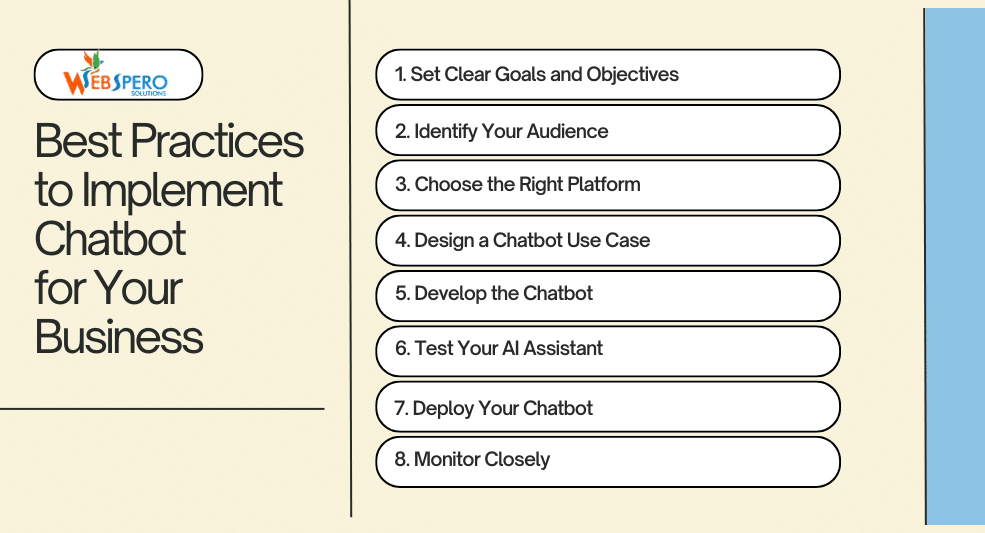
Implementing a chatbot into an enterprise can significantly boost productivity; however, it does require careful planning. Make sure you follow these to implement a chatbot into your organization best.
Set Clear Goals and Objectives
Before even developing a chatbot, you must answer the question, why exactly do you need a chatbot, or what do you want it to accomplish? Is it to provide 24/7 customer support? Is it to filter out candidates? A clear goal can help you with the development process.
Identify Your Audience
Similar to why you need a chatbot, you need to answer the following question: Who is this chatbot for? Will it be for a younger audience? Will it be strictly used within your organization? Answering these questions will help you set the tone and capabilities of your chatbot.
Choose the Right Platform
With so many chatbot platforms available, such as OpenAI, Gemini, Anthropic, and more, it can be difficult to choose one. You need to research what works best for your organization. To cut down on your research time, you can opt for professional services like ours. We can help you find the perfect chatbot platform with our Expert Generative AI Consulting.
| NOTE: If you are aiming to create a chatbot from scratch, it will take immense effort and time; however, you will have complete control of your AI assistant. Development costs are higher for this approach. |
Design a Chatbot Use Case
It is crucial that you create chatbot use cases. These conversational flows act as a guide for a chatbot regarding what users may ask it, allowing you to build a truly valuable virtual assistant.
Develop the Chatbot
By now, you should have a clear understanding of how you want your chatbot to be, and it’s time to build it. This process involves building a knowledge base and training the AI model. At WebSpero Solutions, our seasoned developers can help you with personalized AI Chatbot Development, creating the AI agent the way you want it, just the way you want it.
Test Your AI Assistant
This goes for every development process. Make sure you thoroughly test your chatbot. This will help you identify any issues or bugs (these are not uncommon during the development phase), allowing you to refine and perfect your chatbot.
Deploy Your Chatbot
Once your virtual assistant is tested rigorously and is error-free, it is time to launch it. Develop a communication plan to launch the chatbot to your target audience. Our expert social media marketing and media outreach services can help you increase your new chatbot’s reach and visibility on social media and media outlets.
Monitor Closely
While your chatbot may be great at the launch, users can provide feedback to make it perfect. Gather and analyze the data to identify areas of improvement and update the chatbot accordingly.
Considerations for Chatbots
While implementing the AI agent for your business, consider the following.
Data Privacy and Security
It is crucial that your chatbot adheres to privacy regulations. Also, each country has different rules regarding information data privacy and information collection, so make sure your virtual assistant is regulated.
Accessibility
When developing your AI chatbot to target audience, it is important that you make your make it accessible to users with disabilities. For instance, having an error-free text-to-speech feature for visually impaired users.
Human Support
As mentioned above, it is crucial to provide an option to connect with human agents within your chatbot. This can be when the virtual assistant struggles with complex issues or if a customer wants to interact with a real person.
Challenges of Chatbots
Despite the huge advantages of chatbots, there are certain challenges that come with them.
Limited Understanding
Despite advancements in AI, chatbots can still struggle with understanding complex queries or context-specific language. This can lead to miscommunication and frustrated customers. Hence, need for human sales representatives.
Retraining Downtime
While retraining the chatbot isn’t too expensive, depending on the training data and goal, it can take up to a month.
Data Privacy Concerns
Chatbots often handle sensitive customer information, raising concerns about data security and privacy. If you choose a platform that isn’t compliant with regulations or easy to hack, it can lead to a data breach.
Future of Chatbots for Businesses
While it may seem as if we are in the golden age of virtual assistants, this is just a glimpse of what is to come. The tech industry is advancing rapidly, and with more sophisticated artificial intelligence and generative models, we may be looking forward to a chatbot similar to Iron Man’s Jarvis.
As for present chatbots, they are excellent tools to boost productivity and automate mundane tasks. Follow the mentioned practices to best implement them within your business for maximum productivity and growth.
